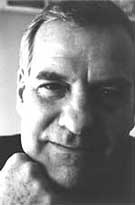|
|||||||||||||||
|
The Story
Resources
Background
|
By Chris Julin and Stephanie Hemphill
June 2001

|
|
|
In the mid 1970s, Michael Fedo set out to write a novel, and ended up writing a history of the lynching in Duluth. Fedo says he didn't write the book to crusade for social justice, but because he thought he could get it published. Listen to his comments. (Photo courtesy of Minnesota Historical Society Press) |
Twenty years after Lewis' novel, Bob Dylan recorded his song, Desolation Row. Dylan was born in Duluth. His father lived in a downtown apartment at the time of the lynching, and almost certainly knew about it. Bob Dylan's song contains several fragments of the lynching story - the circus, a riot squad, the waffling police commissioner.
Ten more years passed, and in the mid-1970s, a teacher in the Twin Cities named Michael Fedo decided to write a historical novel. He planned to set the story in the early part of the century in his hometown of Duluth. As Fedo put together an outline of the book, he remembered something his mother had mentioned years before, in passing. There'd been a lynching. He knew nothing more about it, but he thought it might add a dramatic twist to his novel.
"It was going to be a peripheral event that I was going to include in a chapter perhaps. I would just simply pick up the book that somebody must have written back in 1925 or so - only to discover there was no book," says Fedo. "The historical society had a folder that had a few clippings it, so I just started to poke around. After reading about it over the course of a week or two, I filled a spiral notebook with notes, and then I decided this is the story. This should have been written years ago, and I forgot about the novel and wrote this instead."
Fedo's book came out in 1979. He says the initial response was, "overwhelming indifference." He sold about 3,000 copies before the small publisher went bankrupt. But it did get some people talking. A few high school teachers started using excerpts in their history classes. Local newspapers sometimes ran stories on the anniversary of the lynching. And a few people got to wondering about the question Fedo raised in the last paragraph of the book.
Where were the bodies?
Next: Dignifying the Dead

